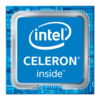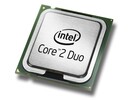Intel Core 2 Duo SU7300 vs Intel Celeron N5105 vs Intel Core 2 Duo T9900
Intel Core 2 Duo SU7300
► remove from comparisonThe Intel Core 2 Duo SU7300 is a CULV laptop processor for small and light laptops. Due to the small clock speed, the CPU is specified with a TDP of only 10 Watt. For non demanding tasks, the performance of both cores is sufficient. Many laptops with the SU7300 feature an overclocking option to run the CPU at higher clock rates (e.g. 1.7 GHz in the Asus UL series). Compared to the Atom series, the SU7300 is signifantly faster.
Intel Celeron N5105
► remove from comparison
The Intel Celeron N5105 is a quad-core SoC of the Jasper Lake series that is primarily intended for inexpensive desktops and was announced in early 2021. The four Tremont CPU cores clock between 2 and 2.9 GHz (single core Burst) and offer no HyperThreading (SMT). The N5105 uses 1.5 MB L2 and 4 MB L3 cache. The chip is manufactured in 10nm at Intel (most likely in the same process as Ice Lake).
CPU Architecture
The processor architecture is called Tremont and a complete redesign compared to the old Golmont Plus cores in the predecessor. According to Intel, the single thread performance of a core could be improved by 30% on average (10 - 80% in all tests of SPECint and SPECfp).
Features
In addition to the quad-core CPU block, the SoC integrates a 24 EU Intel UHD Graphics GPU clocked from 450 - 800 MHz and a LPDDR4(x) dual channel memory controller (up to 16 GB and 2933 MHz). The chip now also partly integrates Wi-Fi 6 (Gig+), 8 PCIe 3.0 lanes, 14 USB 2.0/ 3.2 ports and two SATA 6.0 ports. The package got bigger and measures 35 x 24 mm (compared to 25 x 24 mm for the N5030 e.g.). The SoC is directly soldered to the mainboard (BGA) and can't be easily replaced.
Performance
The average N5105 in our database is in the same league as the Core i3-1005G1 and the Ryzen 3 3250U, as far as multi-thread benchmark scores are concerned. Your mileage may vary depending on how high the CPU power limits are.
Power Consumption
Similar to the predecessor, Intel specifies the TDP with 10 Watts (mobile and lower clocked N5100 6W). The chip can therefore be cooled passively in theory, but SKUs with fans are possible as well.
Intel Core 2 Duo T9900
► remove from comparison
The Intel Core 2 Duo T9900 is the theoretical successor of the Core 2 Extreme X9100 (which also clocks at 3.06 GHz) that uses less power due to the modern stepping and the Enhanced Halt State (C1E). The only advantage of the X9100 is the free multiplikator (which allows easy overclocking of the CPU).
The T9900 is a fast dual core CPU for laptops which features 6 MB of shared level 2 cache and a TDP of 35 Watt. Due to the high clock speed, modern games (in 2009) should not be limited by the CPU speed. For single threaded applications it is one of the fastest CPUs for laptops (only beaten by the new Core i7 with enabled Turbo mode).
The T9900 uses a Penryn (Montevina Update) core that features 2 integer units, 1 floating point unit, 1 load unit, and 1 store unit in a 14-stages long pipeline. Due to the Wide Dynamic Execution Technology, the core is able to simultaneously execute up to four instructions.
The integrated Enhanced Speedstep is able to downclock the core dynamically as low as 800 MHz to save power (in idle mode).
The Core 2 Duo T9900 can be used in a Socket P socket with 479 pins: Socket P / Micro Flip-Chip Pin Grid Array (Micro-FCPGA) requires 479-pin surface mount Zero Insertion Force (ZIF) socket (mPGA479M socket) or Micro Flip-Chip Ball Grid Array (Micro-FCBGA) for surface mount (479-ball).
| Model | Intel Core 2 Duo SU7300 | Intel Celeron N5105 | Intel Core 2 Duo T9900 | ||||||||||||||||||||||||||||||||
| Codename | Penryn | Jasper Lake | Penryn | ||||||||||||||||||||||||||||||||
| Series | Intel Core 2 Duo | Intel Jasper Lake | Intel Core 2 Duo | ||||||||||||||||||||||||||||||||
| Series: Core 2 Duo Penryn |
| ||||||||||||||||||||||||||||||||||
| Clock | 1300 MHz | 2000 - 2900 MHz | 3060 MHz | ||||||||||||||||||||||||||||||||
| FSB | 800 | 1066 | |||||||||||||||||||||||||||||||||
| L2 Cache | 3 MB | 1.5 MB | 6 MB | ||||||||||||||||||||||||||||||||
| Cores / Threads | 2 / 2 | 4 / 4 | 2 / 2 | ||||||||||||||||||||||||||||||||
| TDP | 10 Watt | 10 Watt | 35 Watt | ||||||||||||||||||||||||||||||||
| Transistors | 410 Million | 410 Million | |||||||||||||||||||||||||||||||||
| Technology | 45 nm | 10 nm | 45 nm | ||||||||||||||||||||||||||||||||
| Die Size | 107 mm2 | 107 mm2 | |||||||||||||||||||||||||||||||||
| max. Temp. | 105 °C | 105 °C | 105 °C | ||||||||||||||||||||||||||||||||
| Socket | BGA956 | BGA1338 | Socket P (BGA479, PGA478) | ||||||||||||||||||||||||||||||||
| Features | Enhanced Speedstep, VT-x, TXT | DDR4-2933/LPDDR4x-2933 RAM, PCIe 3, GNA, MMX, SSE, SSE2, SSE3, SSSE3, SSE4.1, SSE4.2, VMX, SMEP, SMAP, EIST, TM1, TM2, Turbo, AES-NI, RDRAND, RDSEED, SHA | SSE4.1, Virtualization Technology, Execute Disable Bit, Enhanced Speedstep, Ehnaced Halt State (C1E), 64 Bit, Trusted Execution Technology | ||||||||||||||||||||||||||||||||
| Architecture | x86 | x86 | x86 | ||||||||||||||||||||||||||||||||
| Announced | |||||||||||||||||||||||||||||||||||
| Manufacturer | ark.intel.com | ark.intel.com | ark.intel.com | ||||||||||||||||||||||||||||||||
| L3 Cache | 4 MB | ||||||||||||||||||||||||||||||||||
| iGPU | Intel UHD Graphics (Jasper Lake 24 EU) (450 - 800 MHz) | ||||||||||||||||||||||||||||||||||
| L1 Cache | 128 KB | ||||||||||||||||||||||||||||||||||
| Voltage | 1.05-1.2125 V V | ||||||||||||||||||||||||||||||||||
| $530 U.S. |
Benchmarks
Average Benchmarks Intel Core 2 Duo SU7300 → 0% n=0
Average Benchmarks Intel Celeron N5105 → 0% n=0
Average Benchmarks Intel Core 2 Duo T9900 → 0% n=0
* Smaller numbers mean a higher performance
1 This benchmark is not used for the average calculation












